The Effect of Forced Melt Flow by a Rotating Magnetic Field and Solid/Liquid Front Velocity on the Size and Morphology of Primary Si in a Hypereutectic Al-18 wt.% Si Alloy
Abstract
1. Introduction
2. Materials and Methods
2.1. Materials and Experiments
2.2. Microstructural and Macrostructural Analysis
2.3. Image Analysis
2.4. Quantitative Measures
2.4.1. Size Factor
2.4.2. Shape Factors
Circularity
Roundness
3. Results and Discussion
3.1. Qualitative Analysis of the Solidified Samples
- Star-like: This structure exhibits needle arms, suggesting growth along their axes (planes) originating from a large nucleus (Figure 5a).
- Polyhedral: Polyhedral structures have multiple flat faces or facets, indicating the presence of well-defined crystal planes during growth. This morphology appears under two subtypes: equiaxed polyhedral morphology (Figure 7b) and elongated polyhedral, or, as adopted in the literature, coarse plate-like morphology (Figure 7d) [24].
- Dendritic: Dendritic structures are characterised by branching, tree-like patterns. The dendritic morphology appears under two subtypes: an equiaxed dendritic shape (Figure 7c) and an elongated dendritic shape (feathery) (Figure 7e). Feather-like configurations imply delicate, elongated structures resembling feathers.
3.2. Quantitative Analysis of the Solidified Samples
3.2.1. Size of Primary Si Particles
3.2.2. Shape of Primary Si
- Circularity
- Roundness
4. Conclusions
- Increasing the front velocity during solidification resulted in an increased percentage of fine primary Si particles (<200 µm) and a decreased percentage of coarse primary Si particles (>200 µm), leading to the refinement of primary Si particles.
- Increasing the front velocity and applying an RMF together during solidification had a better effect on the refinement of primary Si particles.
- Increasing the s/l front velocity during solidification in non-stirred sections reduced dendritic percentages and increased star-like particles, while polyhedral percentages remained constant. The percentages of dendritic, star-like, and polyhedral Si shapes were relatively stable across different front velocities in stirred parts.
- Higher s/l front velocities decrease elongated dendritic and polyhedral primary Si particles, while increasing their equiaxed forms, in stirred and non-stirred parts.
Author Contributions
Funding
Institutional Review Board Statement
Informed Consent Statement
Data Availability Statement
Acknowledgments
Conflicts of Interest
References
- Nayak, S.; Karthik, A. Synthesis of Al-Si alloys and study of their mechanical properties. Mater. Eng. 2011, 1–61. [Google Scholar]
- Nur, M.A.; Kaiser, M.S. Corrosion Behaviour of Hypereutectic Al-Si Automotive Alloy in Different pH Environment. Int. J. Mech. Mater. Eng. 2017, 11, 1736–1740. Available online: https://www.researchgate.net/publication/320991020 (accessed on 10 November 2017).
- Fisher, D.J.; Kurz, W. A theory of branching limited growth of irregular eutectics. Acta Met. 1980, 28, 777–794. [Google Scholar] [CrossRef]
- Wołczyński, W. Pattern selection in the eutectic growth—Thermodynamic interpretation. Arch. Met. Mater. 2020, 65, 653–666. [Google Scholar] [CrossRef]
- Saifutdinov, I.; Lebedev, V.G. Self-similar approximation for the process of formation of microporosity in alloys of light metals. J. Eng. Phys. Thermophys. 2013, 86, 743–753. [Google Scholar] [CrossRef]
- Pequet, C.; Rappaz, M.; Gremaud, M. Modeling of microporosity, macroporosity, and pipe-shrinkage formation during the solidification of alloys using a mushy-zone refinement method: Applications to aluminum alloys. Met. Mater. Trans. A Phys. Met. Mater. Sci. 2002, 33, 2095–2106. [Google Scholar] [CrossRef]
- Sun, Y.; Wang, Q.; Geng, H. Effects of complex modificating technique on microstructure and mechanical properties of hypereutectic Al-Si alloys. J. Mater. Sci. 2012, 47, 2104–2109. [Google Scholar] [CrossRef]
- Cui, C.; Schulz, A.; Matthaei-Schulz, E.; Zoch, H.W. Characterization of silicon phases in spray-formed and extruded hypereutectic Al-Si alloys by image analysis. J. Mater. Sci. 2009, 44, 4814–4826. [Google Scholar] [CrossRef]
- Yu, J.; Ren, Z.; Deng, K. Refinement and migrating behaviors in Al-Si hypereutectic alloys solidified under electromagnetic vibration. Acta Met. Sin. Engl. Lett. 2011, 24, 301–308. [Google Scholar] [CrossRef]
- Al-Omari, K.; Roósz, A.; Rónaföldi, A.; Veres, Z. Effect of Forced Melt Flow on Al–Si Eutectic-Alloy Microstructures. Crystals 2022, 12, 731. [Google Scholar] [CrossRef]
- Zakaraia, D.; Roósz, A.; Rónaföldi, A.; Veres, Z. Influence of Magnetic Stirring and Eutectic Front Velocity on the Solidified Microstructure of Al-18 wt.% Si Alloy. Materials 2024, 17, 6029. [Google Scholar] [CrossRef] [PubMed]
- Xu, C.L.; Jiang, Q.C. Morphologies of primary silicon in hypereutectic Al-Si alloys with melt overheating temperature and cooling rate. Mater. Sci. Eng. A 2006, 437, 451–455. [Google Scholar] [CrossRef]
- Ullah, M.W.; Carlberg, T. Silicon crystal morphologies during solidification refining from AlSi melts. J. Cryst. Growth 2011, 318, 212–218. [Google Scholar] [CrossRef]
- Yan, P.; Mao, W.; Fan, J.; Wang, B. Simultaneous refinement of primary Si and modification of eutectic Si in A390 alloy assisting by Sr-modifier and Serpentine Pouring Channel Process. Materials 2019, 12, 3109. [Google Scholar] [CrossRef]
- Rónaföldi, A.; Kovács, J.; Roósz, A. Solidification Facility Equipped with a Magnetohydrodynamic Stirrer; University of Miskolc (UOM): Miskolc, Hungary, 2006. [Google Scholar]
- Al-Omari, K.; Roósz, A.; Rónaföldi, A.; Svéda, M.; Veres, Z. Macrosegregation Evolution in Eutectic Al-Si Alloy under the Influence of a Rotational Magnetic Field. Metals 2022, 12, 1990. [Google Scholar] [CrossRef]
- Veres, Z.; Roósz, A.; Rónaföldi, A.; Sycheva, A.; Svéda, M. The effect of melt flow induced by RMF on the meso- and micro-structure of unidirectionally solidified Al–7wt.% Si alloy Benchmark experiment under magnetic stirring. J. Mater. Sci. Technol. 2022, 103, 197–208. [Google Scholar] [CrossRef]
- Al-omari, K.; Veres, Z. Complex characterization of irregular eutectic structure. Hung. Mater. Chem. Sci. Eng. 2020, 45, 171–181. [Google Scholar]
- Shanthi, C.; Kingsley Porpatham, R.; Pappa, N. Image analysis for particle size distribution. Int. J. Eng. Technol. 2014, 6, 1340–1345. [Google Scholar]
- Tiago, F.; Rasband, W. ImageJ User Guide. Available online: https://imagej.net/ij/docs/guide (accessed on 2 October 2012).
- Wołczyński, W. Pattern selection in the frame of thermodynamic similarity between eutectics: Cu-Cu2O and (Zn)-Zn16Ti—Experiment. Arch. Met. Mater. 2018, 63, 1555–1564. [Google Scholar] [CrossRef]
- Zimmermann, G.; Weiss, A. Directional solidification of dendritic microstructures in microgravity and with forced melt flow. Microgravity Sci. Technol. 2005, 16, 143–147. [Google Scholar] [CrossRef]
- Eckert, S.; Nikrityuk, P.A.; Willers, B.; Räbiger, D.; Shevchenko, N.; Neumann-Heyme, H.; Travnikov, V.; Odenbach, S.; Voigt, A.; Eckert, K. Electromagnetic melt flow control during solidification of metallic alloys. Eur. Phys. J. Spec. Top. 2013, 220, 123–137. [Google Scholar] [CrossRef]
- Al-helal, K. New Approaches to Casting Hypereutectic Al-Si Alloys to Achieve Simultaneous Refinement of Primary Silicon and Modification of Eutectic Silicon. Ph.D. Thesis, Brunel University, London, UK, 2020. [Google Scholar] [CrossRef]
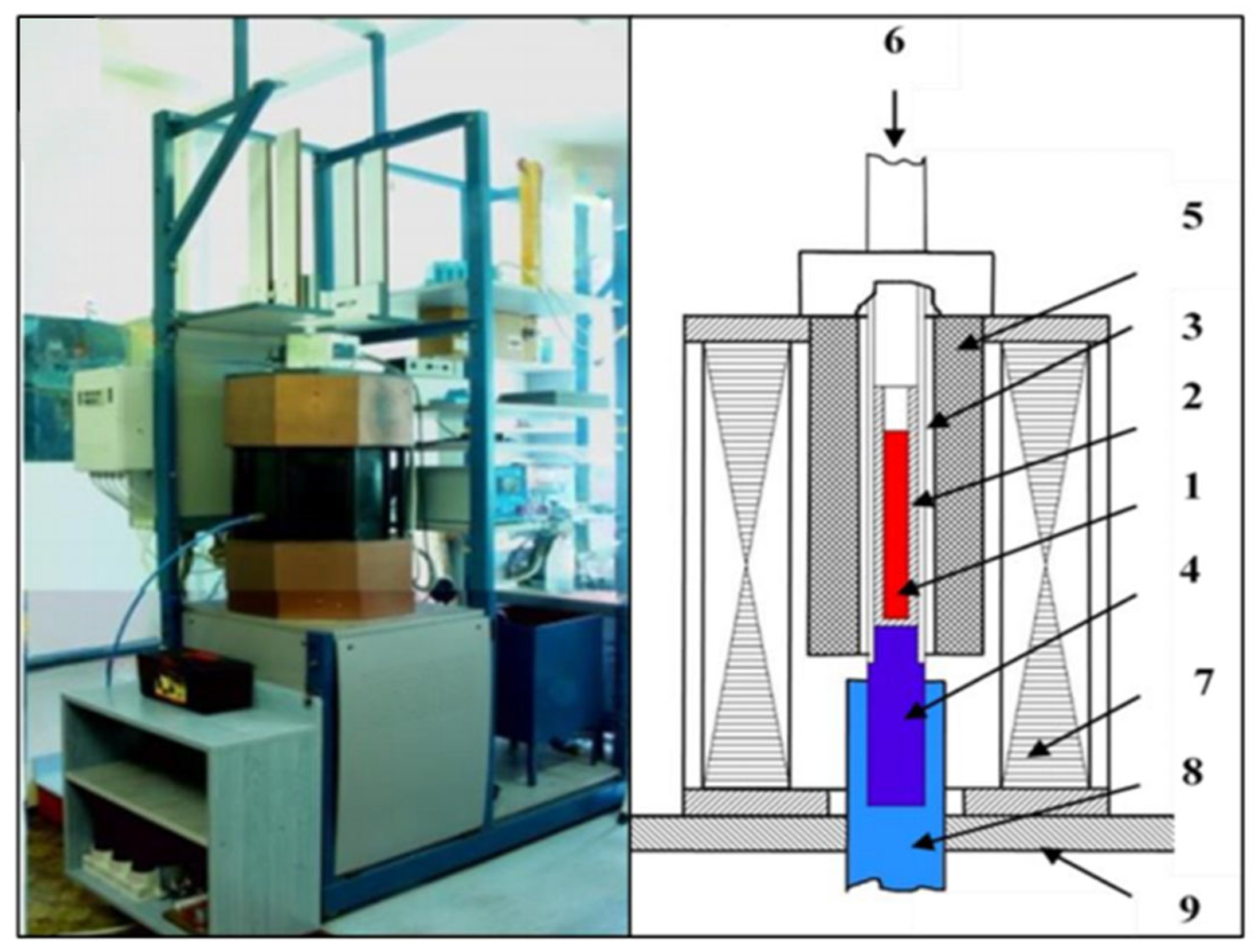
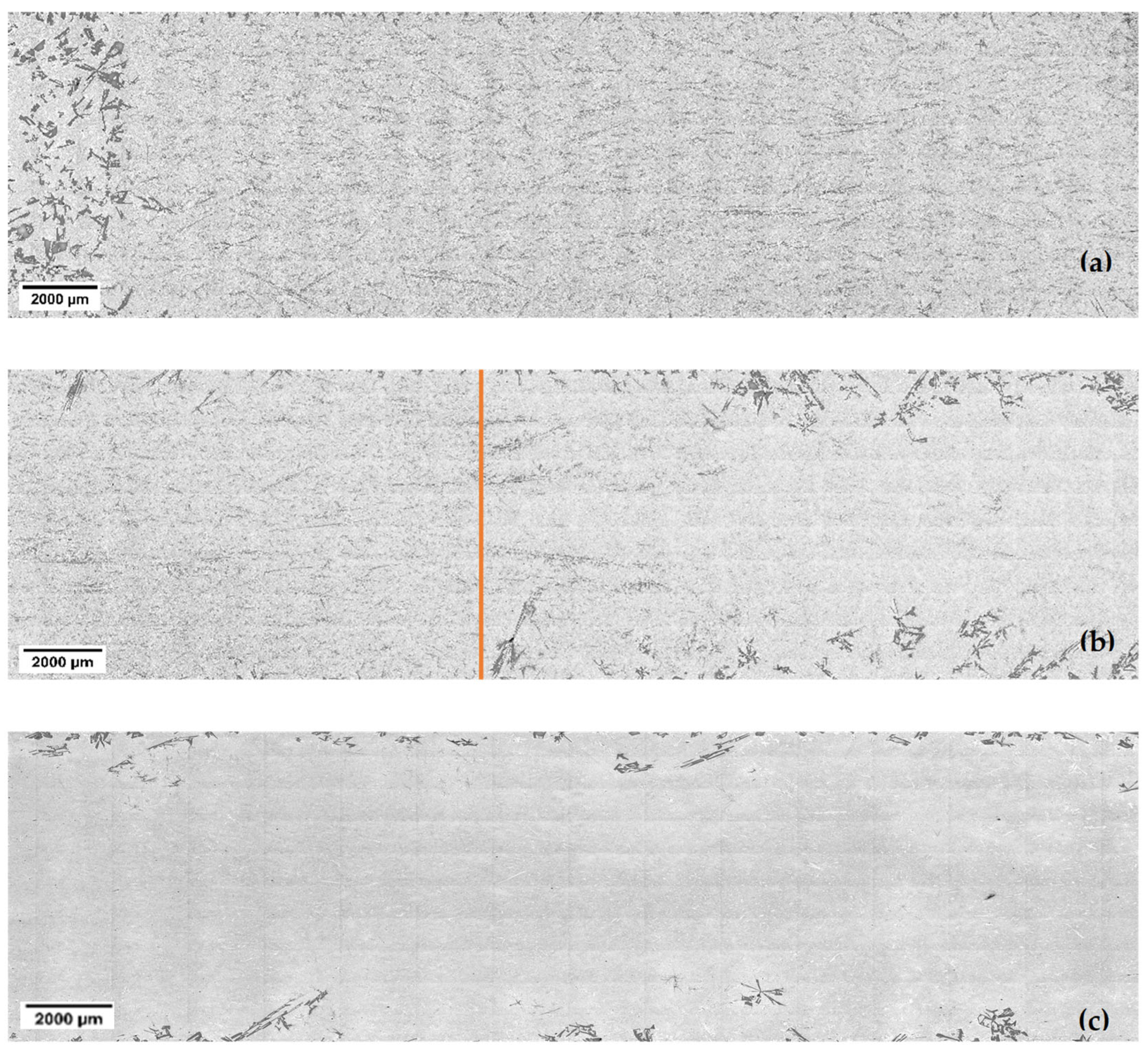
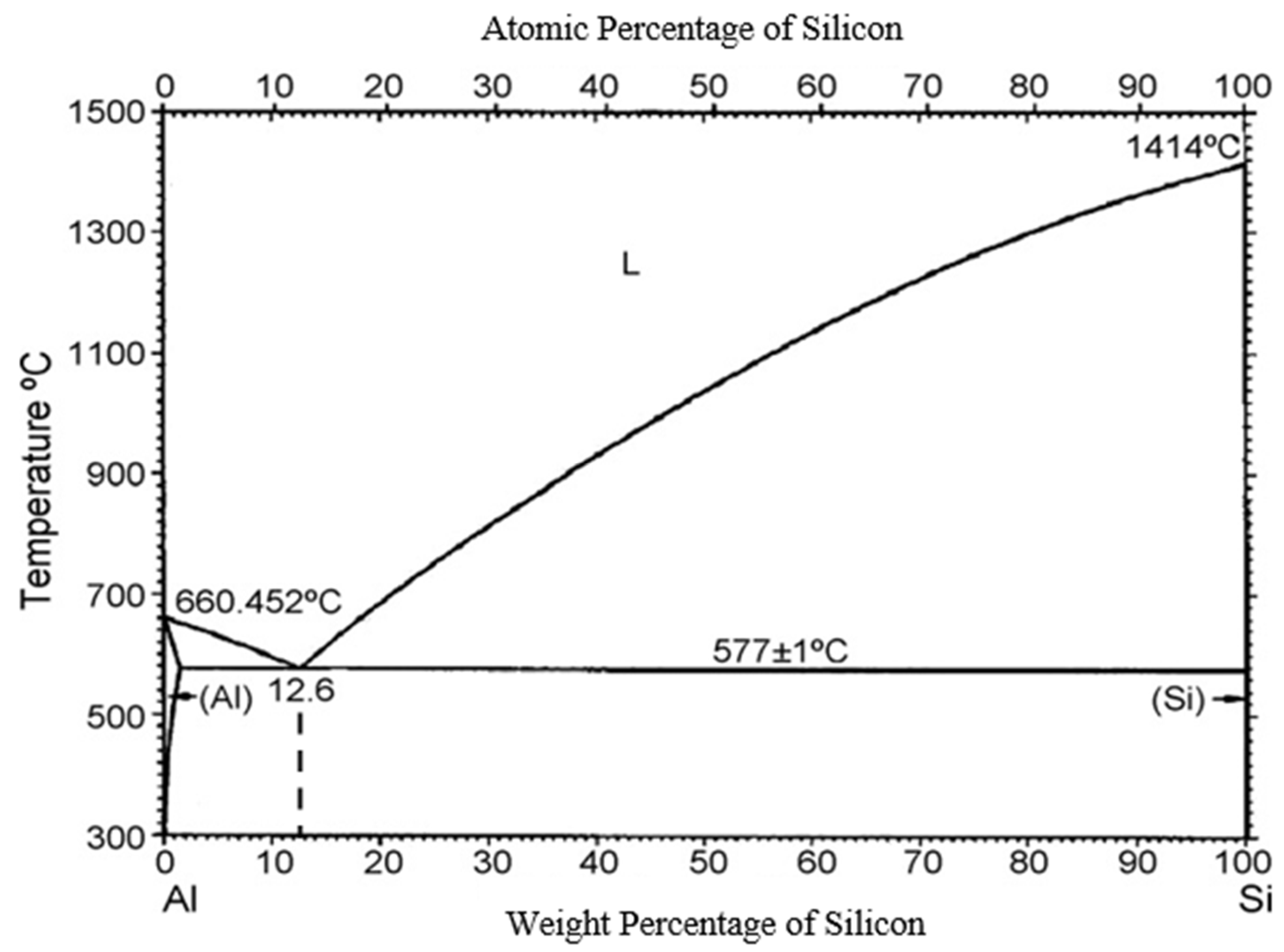

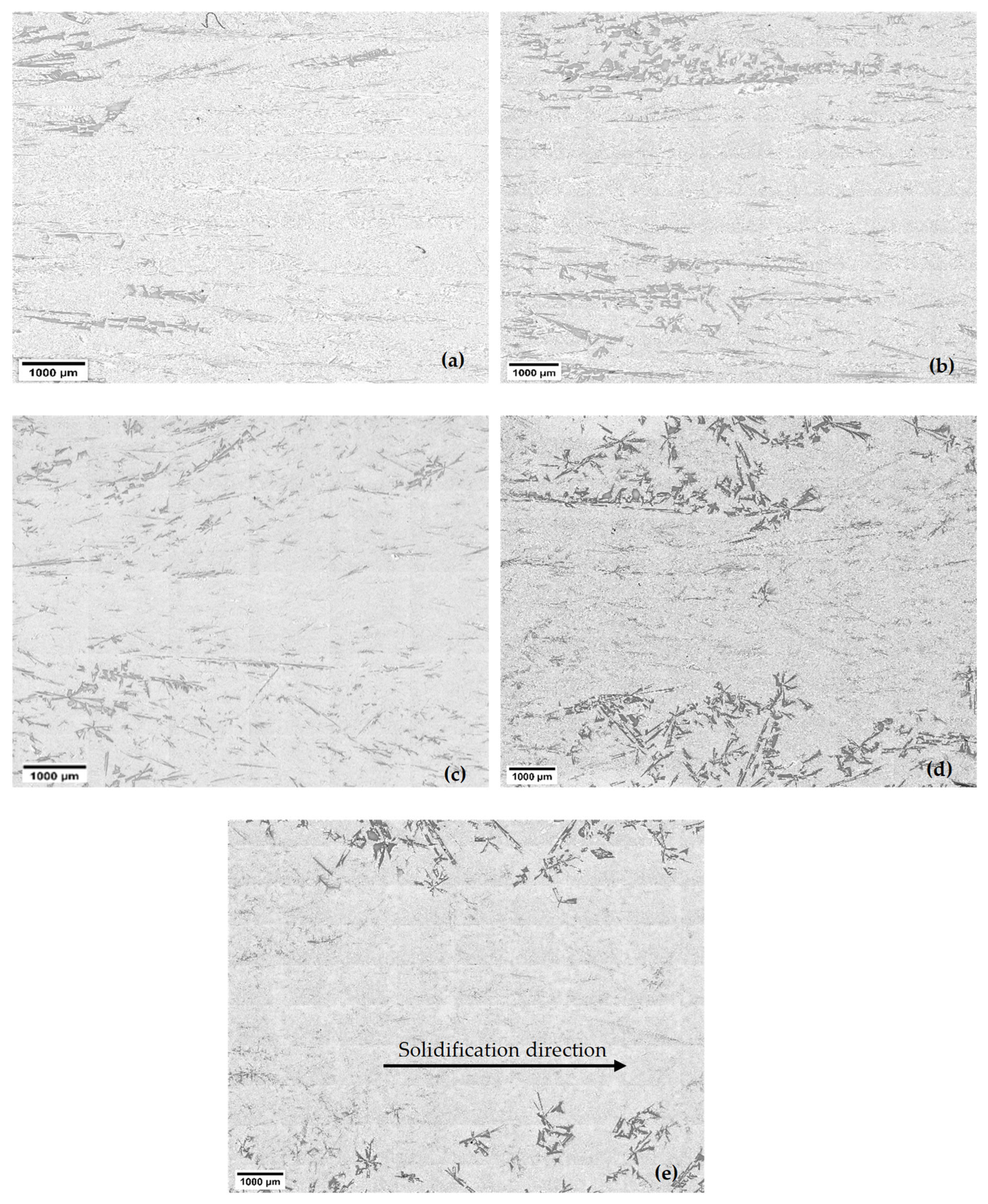
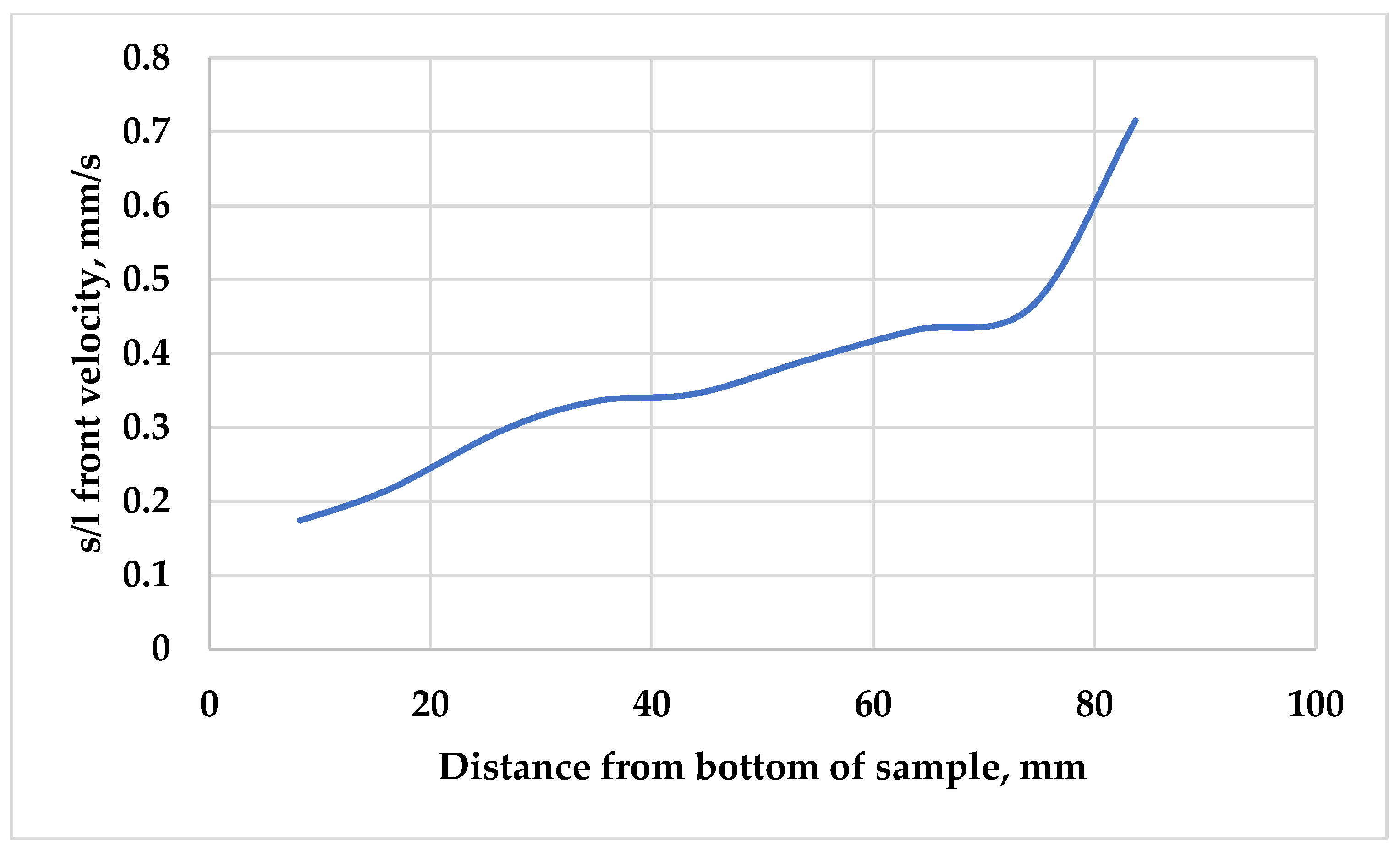
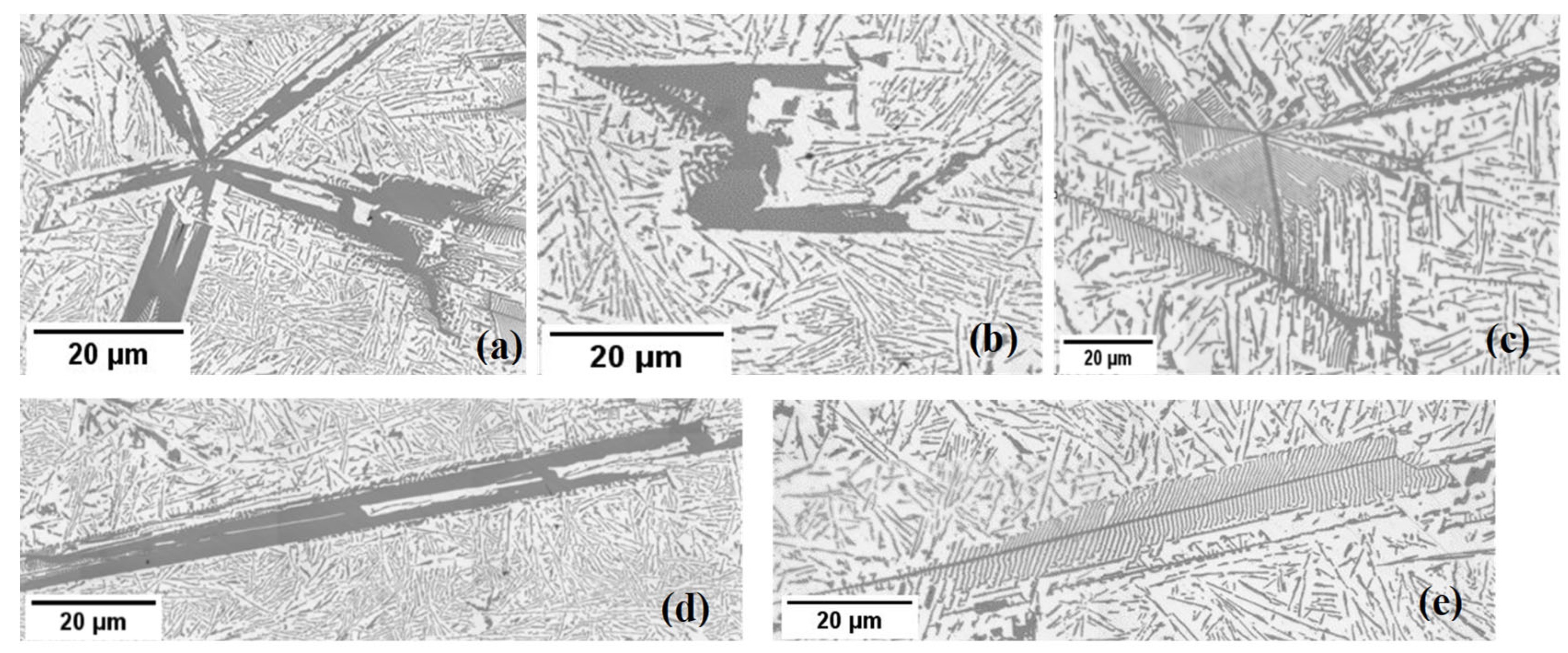

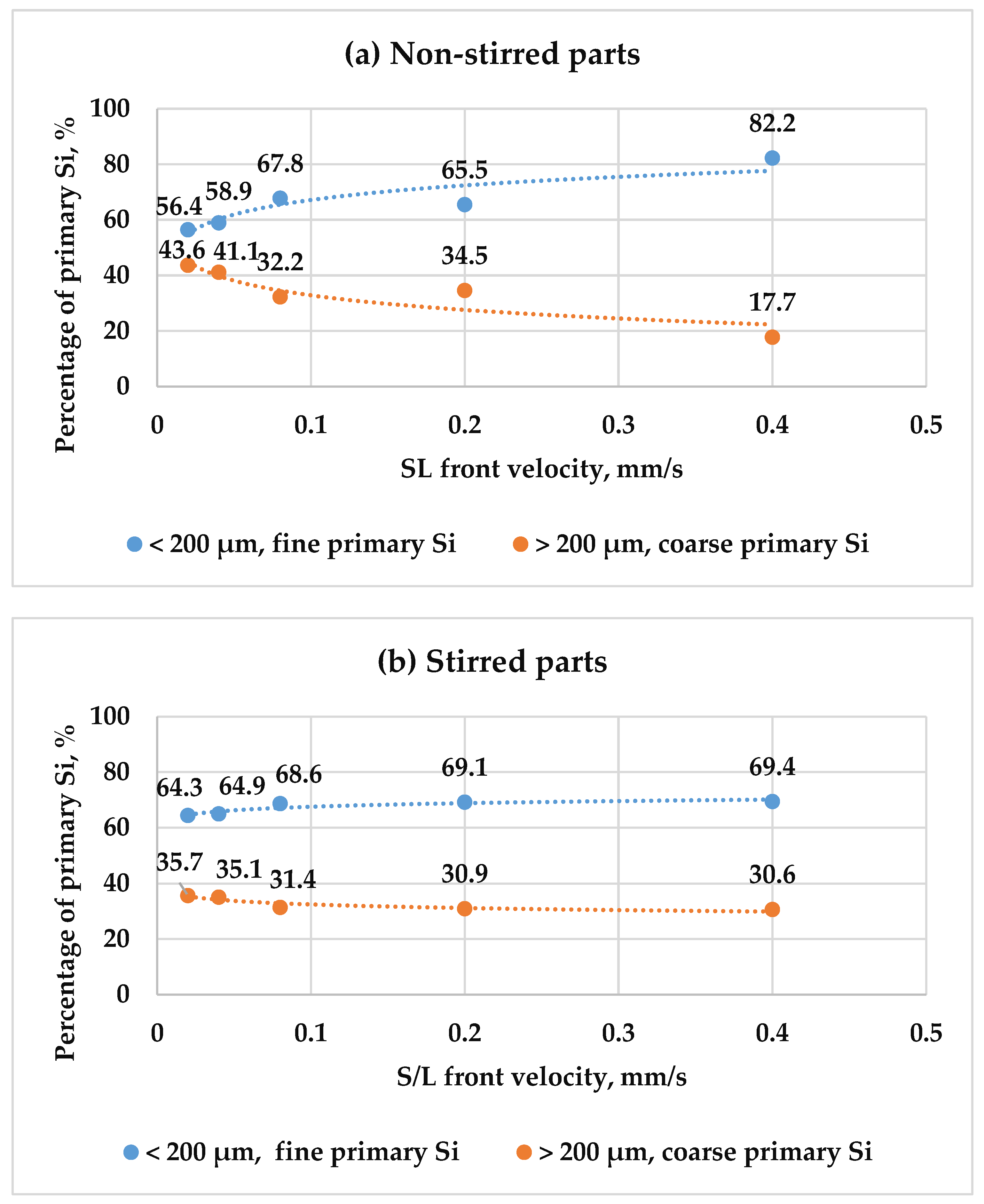
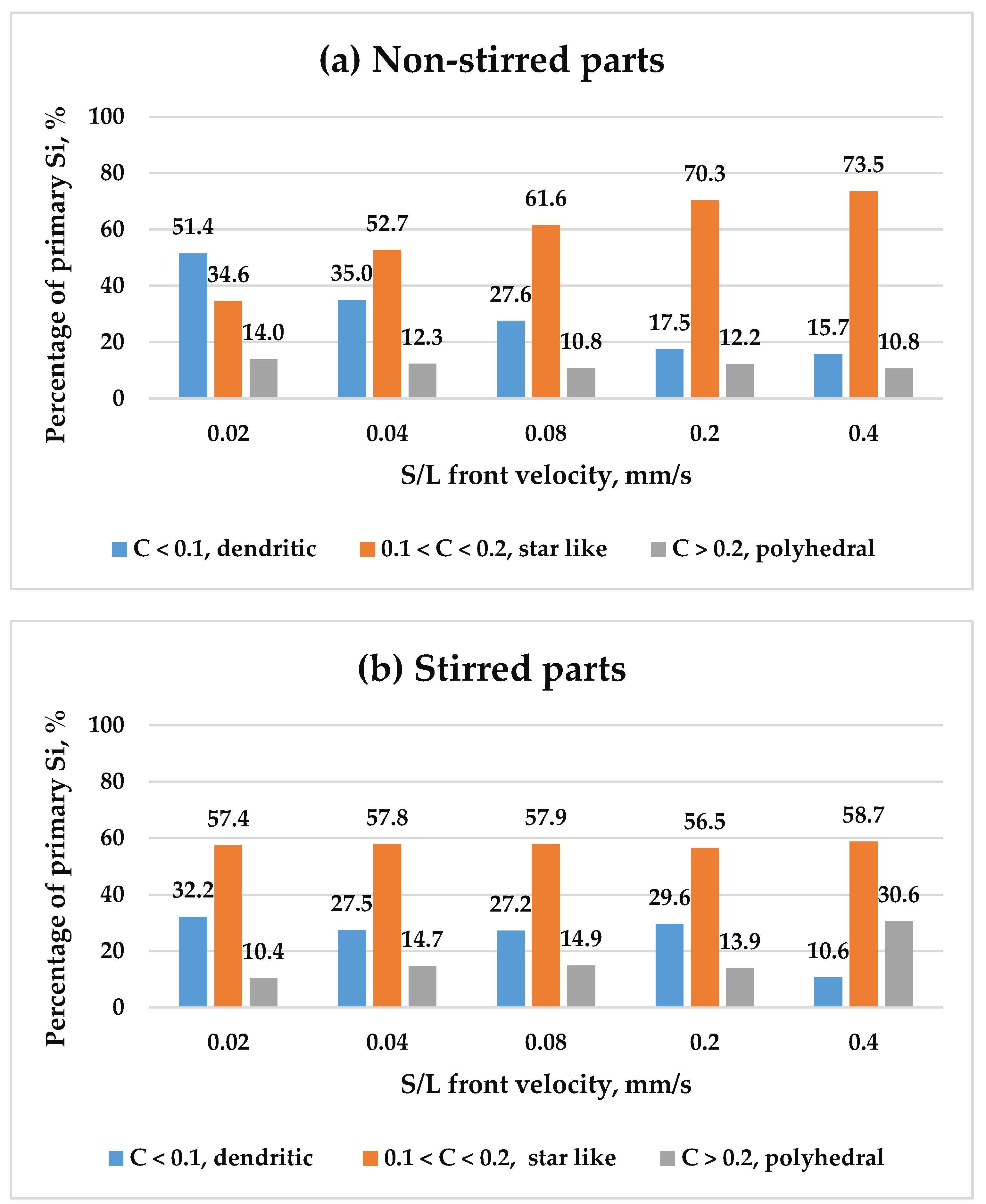
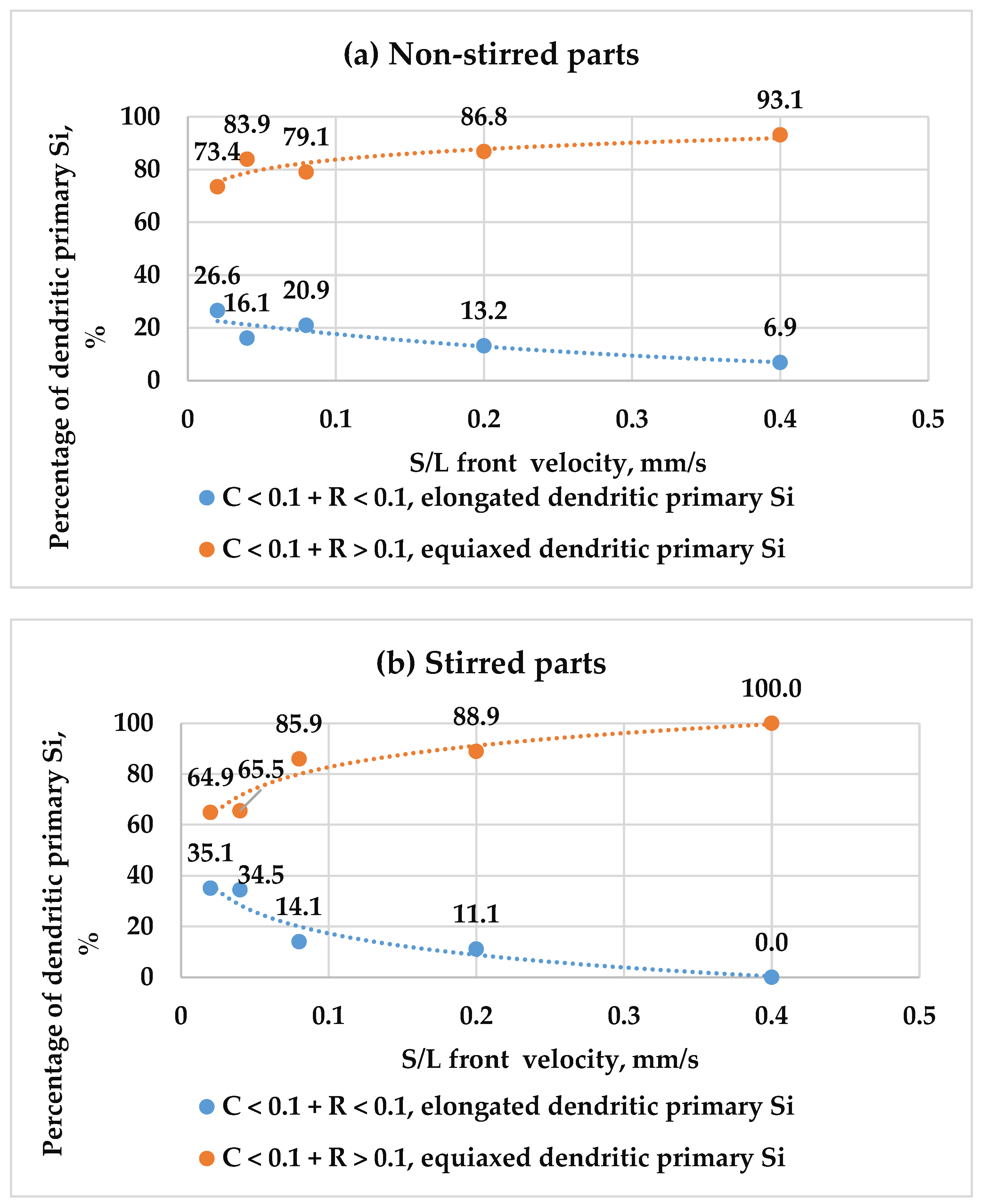
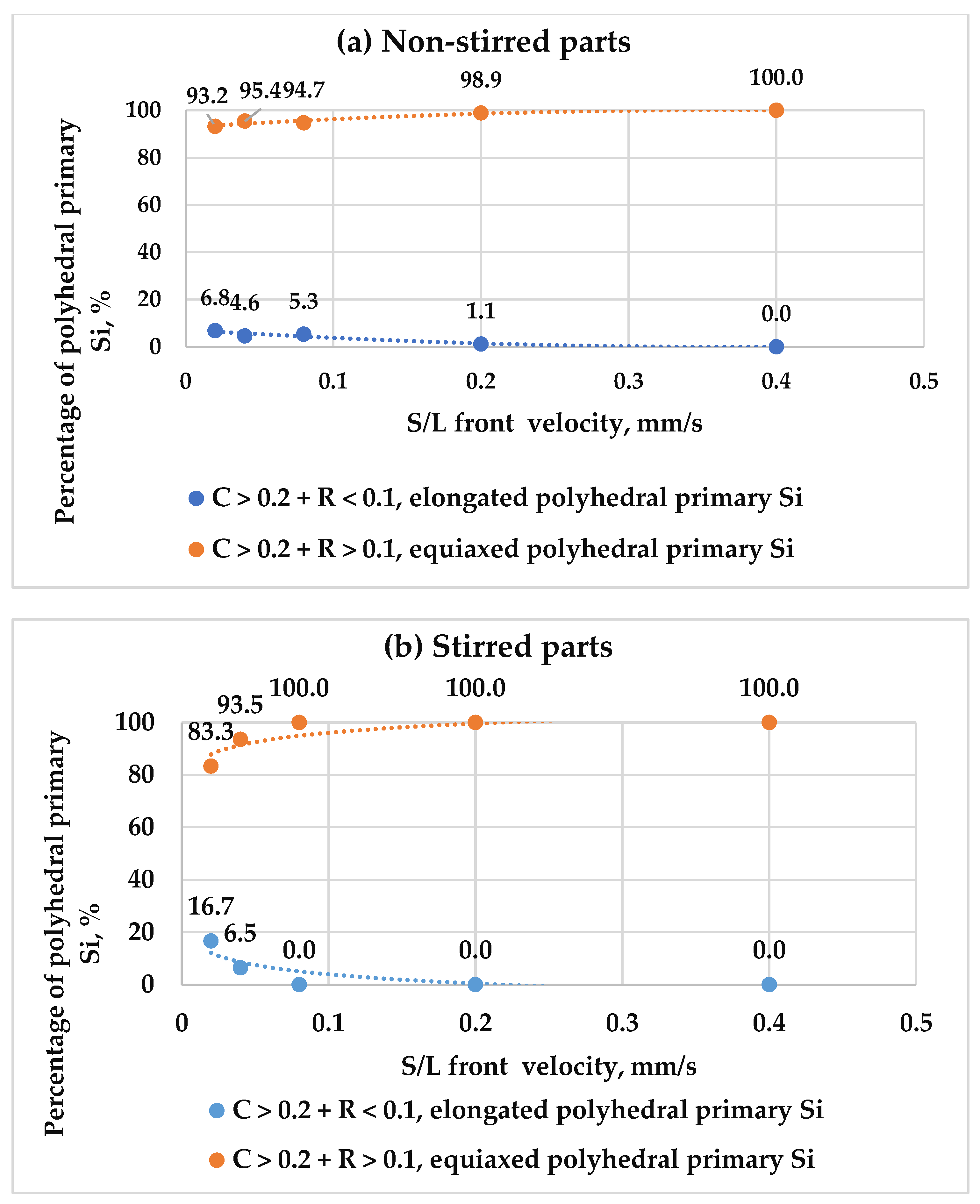
| Name of Sample | [mm/s] | Magnetic Induction of RMF, B [mT] | Temperature Gradient, G [K/mm] |
|---|---|---|---|
| A | 0.02 | 0–7.2 | 8 |
| B | 0.04 | 0–7.2 | 8 |
| C | 0.08 | 0–7.2 | 8 |
| D | 0.20 | 0–7.2 | 8 |
| E | 0.40 | 0–7.2 | 8 |
| Shape Description | Shape Description | Average of Circularity | Standard Deviation | Average of Roundness | Standard Deviation |
|---|---|---|---|---|---|
| Polyhedral | Equiaxed polyhedral | 0.59 | 0.07 | 0.58 | 0.16 |
| Elongated polyhedral (plate-like) | 0.22 | 0.06 | 0.07 | 0.02 | |
| Dendritic | Equiaxed dendritic | 0.08 | 0.01 | 0.33 | 0.07 |
| Elongated dendritic (feathery) | 0.05 | 0.02 | 0.07 | 0.02 | |
| Star-like | Star-like | 0.12 | 0.02 | 0.43 | 0.19 |
Disclaimer/Publisher’s Note: The statements, opinions and data contained in all publications are solely those of the individual author(s) and contributor(s) and not of MDPI and/or the editor(s). MDPI and/or the editor(s) disclaim responsibility for any injury to people or property resulting from any ideas, methods, instructions or products referred to in the content. |
© 2025 by the authors. Licensee MDPI, Basel, Switzerland. This article is an open access article distributed under the terms and conditions of the Creative Commons Attribution (CC BY) license (https://creativecommons.org/licenses/by/4.0/).
Share and Cite
Zakaraia, D.; Roósz, A.; Rónaföldi, A.; Veres, Z. The Effect of Forced Melt Flow by a Rotating Magnetic Field and Solid/Liquid Front Velocity on the Size and Morphology of Primary Si in a Hypereutectic Al-18 wt.% Si Alloy. Materials 2025, 18, 2581. https://doi.org/10.3390/ma18112581
Zakaraia D, Roósz A, Rónaföldi A, Veres Z. The Effect of Forced Melt Flow by a Rotating Magnetic Field and Solid/Liquid Front Velocity on the Size and Morphology of Primary Si in a Hypereutectic Al-18 wt.% Si Alloy. Materials. 2025; 18(11):2581. https://doi.org/10.3390/ma18112581
Chicago/Turabian StyleZakaraia, Dimah, András Roósz, Arnold Rónaföldi, and Zsolt Veres. 2025. "The Effect of Forced Melt Flow by a Rotating Magnetic Field and Solid/Liquid Front Velocity on the Size and Morphology of Primary Si in a Hypereutectic Al-18 wt.% Si Alloy" Materials 18, no. 11: 2581. https://doi.org/10.3390/ma18112581
APA StyleZakaraia, D., Roósz, A., Rónaföldi, A., & Veres, Z. (2025). The Effect of Forced Melt Flow by a Rotating Magnetic Field and Solid/Liquid Front Velocity on the Size and Morphology of Primary Si in a Hypereutectic Al-18 wt.% Si Alloy. Materials, 18(11), 2581. https://doi.org/10.3390/ma18112581







